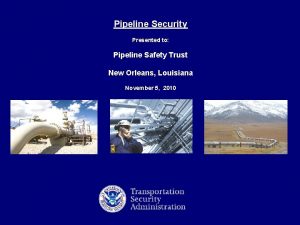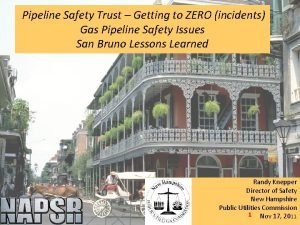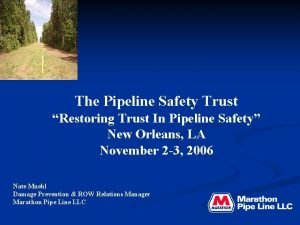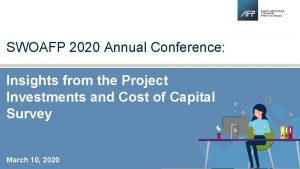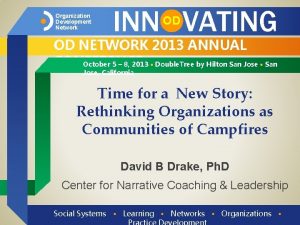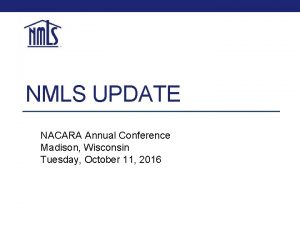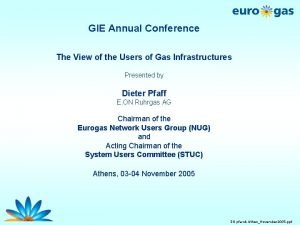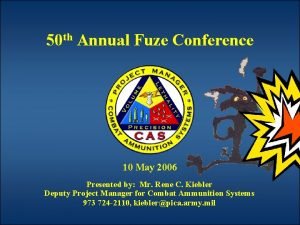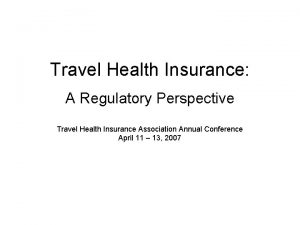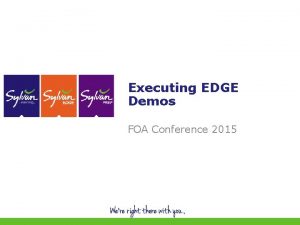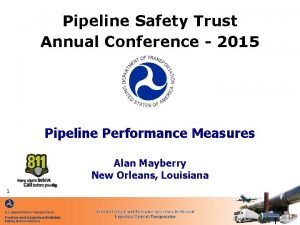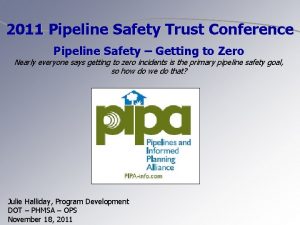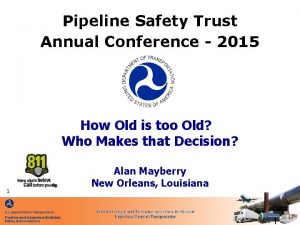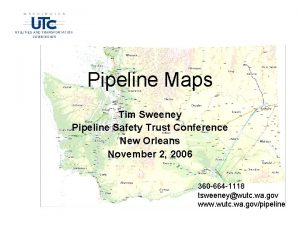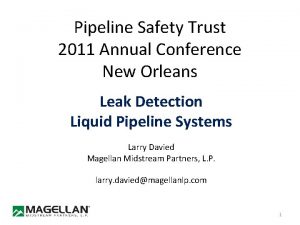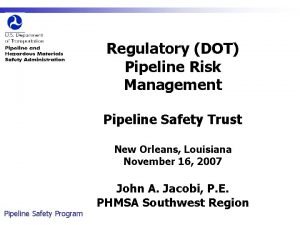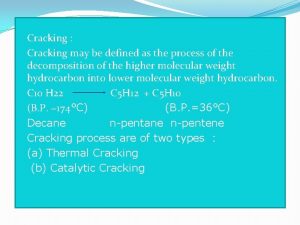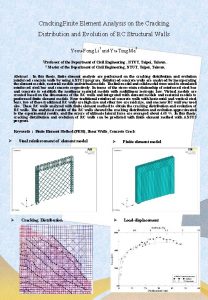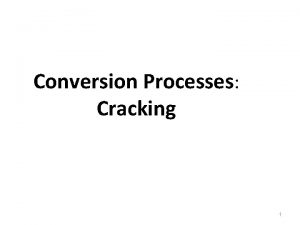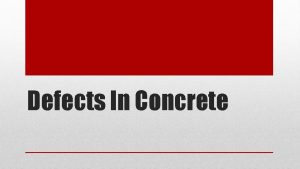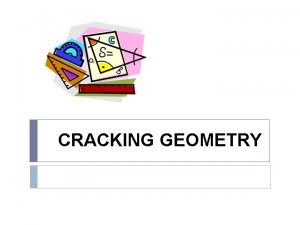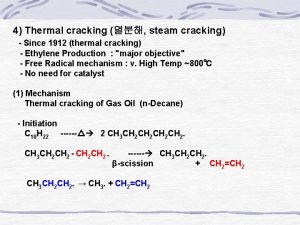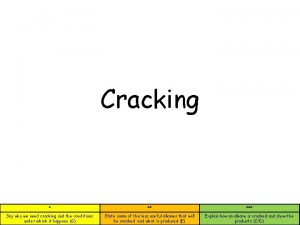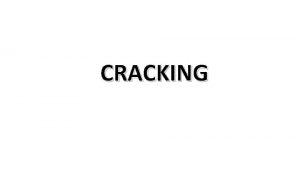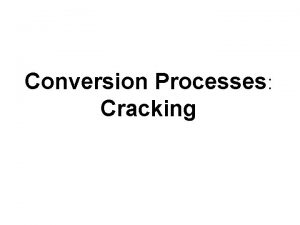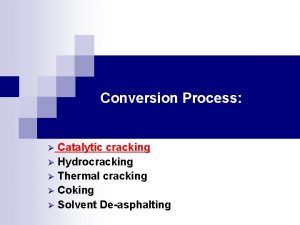Pipeline Safety Trust 2015 Annual Conference Pipeline Cracking























- Slides: 23

Pipeline Safety Trust 2015 Annual Conference Pipeline Cracking & Leak Management Ken Lee – Director, Engineering & Research Division 1 -1 -

PHMSA appreciates industry efforts to develop: • Recommended Practice 1176: Assessment and Management of Pipeline Cracking • Recommended Practice 1175: Pipeline Leak Detection Program Management -2 -

New API Crack & Leak RPs • RPs provide valuable guidance & insight • PHMSA is reviewing drafts and providing feedback to API • PHMSA will review final RP and may consider for possible future incorporation by reference (entirety or portions) -3 -

Recent Incidents Highlighting Crack and Leak Detection Issues Carmichael, MS San Bruno, CA Mayflower, AR Marshall, MI Allentown, PA -4 -

Pipeline Cracking Challenges • One of the top causes of pipeline failures • Many cracks are difficult to detect with current inline inspection tools. • In liquid pipelines, fatigue crack growth occurs from pressure cycling • Current models may not predict failure -5 -

Leak Detection Challenges • Small leaks may be difficult to detect, especially in pipelines of: – High volumes (> 10, 000 barrels/ hour) – Delivering batched or varying products – Locations having other hydrocarbon sources • Valve closure time -6 -

Leak Detection Table 1─Visualization of an Example LDP Leak Rate ð Leak Type SCADA Monitoring CPM Public Awareness Aerial Surveillance In-line inspection Rupture ü ü N/A Medium Leak O ü ü Small Leak X O O ü ü Seep X X O O ü ü Detection Probable O Detection Possible X Detection Improbable Time-to-Detect ð -7 -

Leak Detection Systems Externally-Based Physical Inspection Sensor-Based Monitoring Manual Observations Aerial Surveillance Ground Penetrating Radar Volume or Line Balance Calculations Sniffer Tubes Hydraulic Calculations Hydro Testing Tracer Chemicals Pattern Recognition Satellite Intelligent Pigs Shut-in Testing/Stand-up Testing Continuous Non-Continuous Ground Based Surveillance Line Internally-Based Computational Monitoring Pipeline One Call System/ Public Soil Sampling Awareness Sensing Cables Controller Monitoring Cameras Real Time Line Balance Chemical Analyzers Pressure Monitoring Acoustic Sensors Pattern Recognition CP Monitoring Digital Signal Analysis Statistical Analysis SCADA Conservation of Mass (real time) -8 -

PHMSA Public Workshops • Managing Pipeline Cracking Challenges Workshop – August 5, 2014 (Chicago, IL) • Improving Pipeline Leak Detection Effectiveness – March 27, 2012 (Washington, DC) -9 -

Crack & Leak Management • PHMSA is taking many approaches, including: – Rulemaking – Standards development – Research - 10 -

Regulations Research - 11 -

Pipeline Safety RD&T Program Mission: To sponsor research and development projects focused on providing near-term solutions that will improve the safety, reduce environmental impact, and enhance the reliability of the Nation’s pipeline transportation system. Key Points • We employ a collaborative approach to address mutual challenges • We help remove technical barriers on a given challenge • We measure our research results/impacts • We are transparent - http: //primis. phmsa. dot. gov/rd/ Pipeline Safety Improvement Act of 2002 established our modern program

RD&T Program Objectives Developing Technology Strengthening Consensus Standards Promoting Knowledge Fostering the development of new technologies so that pipeline operators can improve safety performance and more effectively address regulatory requirements. Targeting and feeding new knowledge into the process of keeping standards relevant to their purpose. Generating and promoting general knowledge to decision makers. Authorizations vs. Appropriations FY Authorization: 2002 $10 M 2003 $10 M 2004 $10 M 2005 2006 2007 2008 2009 2010 2011 2012 2013 2014 2015 $10 M $11. 7 M $6. 92 M Appropriation: $4. 8 M $7. 5 M $7. 8 M $7. 7 M $7. 8 M $6. 9 M $5. 8 M $6. 9 M $6. 92 M $12. 3 M

231 Projects, $90 M PHMSA + $85 M Resource Sharing Performance Metrics (since 2002)

PHMSA RD&T SUCCESSES Courtesy: CRC Evens Courtesy: Pipetel Technologies Courtesy: LASEN Courtesy: ITT Kodak Guided Wave Ultrasonics Courtesy: Pure Technologies Leak Detection Gas/Liq Leak Detection by Fixed Wing/ Helicopter along pipeline Hand-Held Tools for In-Ditch Inspections

ERW Pipe Seam Study - 16 -

Lessons Learned – Steel Pipe • Data integration • Conservative approach in sizing • Tool tolerances • Interaction of crack growth • Material properties: toughness • Fatigue crack growth model to predict remaining life • Combination of tools: ILI, Direct, & Pressure Test • Continuous reassessment - 17 -

Improving In Ditch Methods - 18 -

Full Scale Testing to Improve Models - 19 -

Leak Detection Research - 20 -

Research is pointing to: X One size does not fit all 21

Summary • Improving Crack & Leak Detection: – Remain to be difficult issues – Are a high priority – A one-size-fits-all solution is not likely – Appropriate use of multiple tools may be needed - 22 -

Thank you phmsa. dot. gov kenneth. lee@dot. gov 23 - 23 -
 Pipeline safety trust
Pipeline safety trust Pipeline safety trust
Pipeline safety trust Pipeline safety trust
Pipeline safety trust Aashto annual meeting 2015
Aashto annual meeting 2015 Afp annual conference 2020
Afp annual conference 2020 Od network
Od network Problemitize
Problemitize Hepi conference
Hepi conference Nmls resource center
Nmls resource center Gie annual conference
Gie annual conference Annual fuze conference
Annual fuze conference Pbfeam
Pbfeam Travel health insurance association annual conference
Travel health insurance association annual conference Gcyf 2011 annual conference
Gcyf 2011 annual conference Njdv
Njdv Iowa league of cities annual conference
Iowa league of cities annual conference Edgar figueroa md mph
Edgar figueroa md mph Stfm conference
Stfm conference Difference between linear and nonlinear pipeline processors
Difference between linear and nonlinear pipeline processors Paralleism
Paralleism Led conference 2015
Led conference 2015 Ulvan
Ulvan Insight 2015 conference
Insight 2015 conference Charitable work
Charitable work
